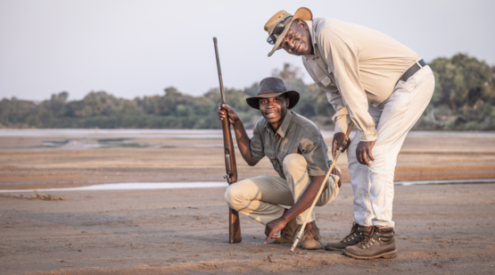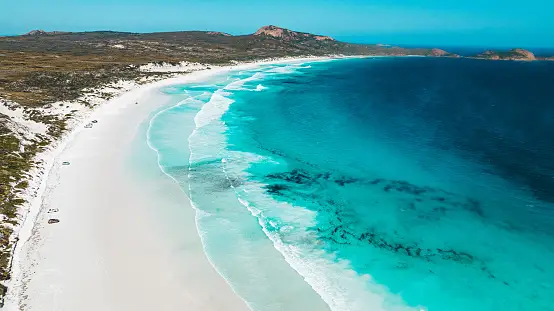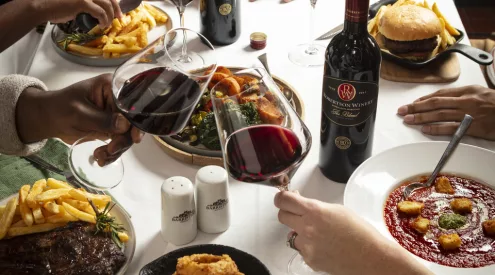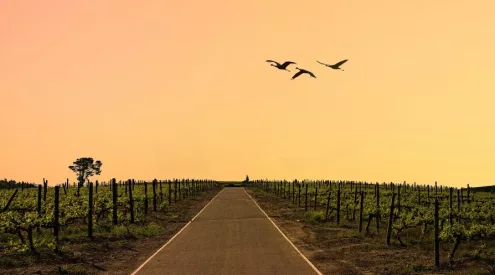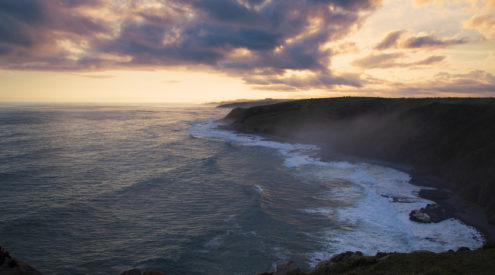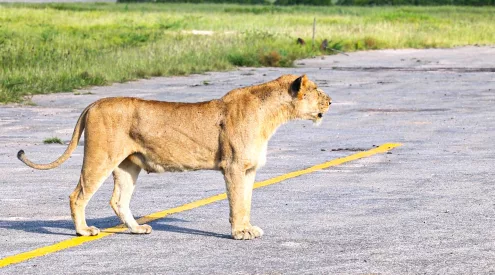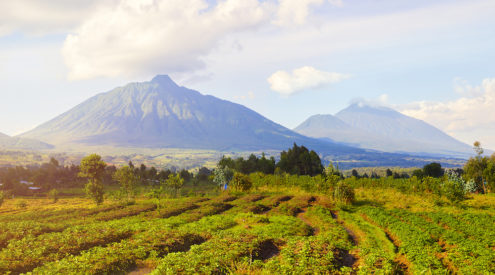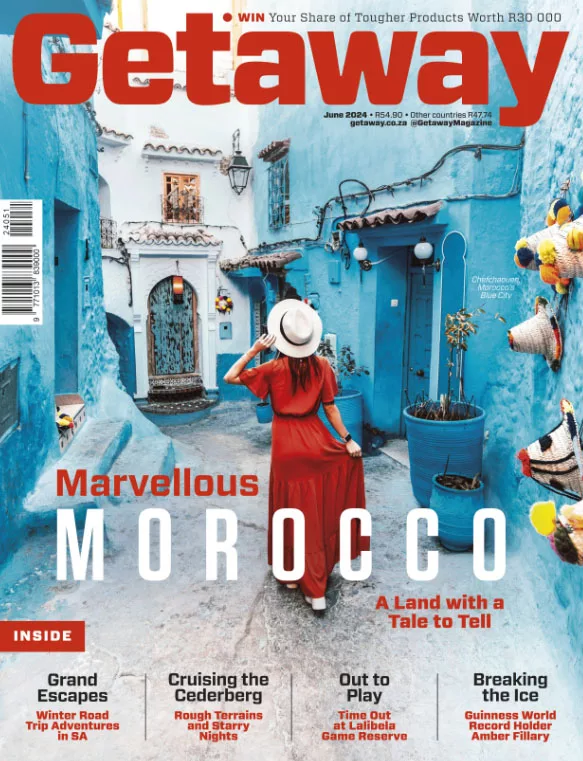In this part of the Gamkaberg Nature Reserve, there is no shade for miles around – the low rainfall means there are no trees on the hills. Down in the valleys, only the hardy acacia thorn trees survive. It’s hard to believe that we’re only 60-odd kilometres from the lush coastal forests on the Indian Ocean shoreline of the southern Cape coast. But the Outeniqua Mountains that run parallel to the coast make a formidable rain barrier. The moisture-laden sea air dumps most of its rain as its forced high over these mountains. By the time a cold front has got to the Gamkaberg, there’s far less water to fall out of the sky.
It’s one of the things that make the Gamkaberg so interesting. On top of the mountain, where the last rain does fall, there is plenty of beautiful, colourful fynbos – proteas, restios, ericas and geophytes. In the kloofs there are thick forests, nourished by the natural springs.
But as soon as you drop down to the northern plains of the mountains, the scenery is completely different. On these vlaktes, it looks more like the Richtersveld or the arid West Coast, where thousands of intricate and delicate succulents eke out a brave existence on the hot, stony ground.
And this is why Tom Barry, Gamkaberg’s Reserve Manager, was lying down on the rocky earth, smiling from ear to ear, looking as comfortable as ever. ‘I’m an arid type of guy. I love this landscape.’ Tom can’t get enough of the tiny succulent plants.
His enthusiasm is infectious. ‘Look here!’ he exclaimed. ‘This is called a perdetand! It’s not protected anywhere else on earth, except here.’
Tom points to a succulent which looks just like a tiny stone, or horse’s tooth, hence the name perdetand. This remarkable plant retreats into the ground during particularly hot and dry days, of which there are many in this part of South Africa. When it does rain a little, usually once or twice a year, the plant emerges about three centimetres out of the ground to take advantage of the moisture.
We look around us, the hill is covered in white quartzite stone. There are hundreds of tiny succulents growing here. ‘The white stones reflect the heat, so it’s cooler here, which the plants enjoy of course.’
There are literally hundreds of species, most with descriptive colloquial names like boesman pieletjie (bushman willies), gaansmis (goose poo), baba boudjies (baby’s bottom) and skoen veter (shoelace). Each has adapted brilliantly to surviving the harsh climate.
It’s a remarkable place which requires someone like Tom to make it come alive. If you didn’t know that there are these beautiful plants here, you’d be forgiven for bypassing this landscape. But it is part of the most diverse arid ecosystem on the planet – the Succulent Karoo, numbering more than 7 000 species of plants, and the Gamkaberg is one of the most south-easterly parts of this biome which extends all the way up the west coast to the Richtersveld. Less than 1% of the Succulent Karoo biome is formally conserved, yet it has around 2 500 plant species which are found nowhere else on earth.
And this is why Tom and his team at CapeNature have raised funds in conjunction with World Wildlife Fund to buy the land on which these delicate plants survive. This property used to be a farm known as Groenefontein. Other farms – identified for their conservation value – have also been purchased, and then sold on to private buyers, who have agreed to manage the farm according to conservation principles. “In this way we can continue funding the purchase of more land for conservation,” Tom said.
When Tom arrived at the 10 000 hectare Gamkaberg Nature Reserve 18 years ago, he realized that the reserve wasn’t big enough to maintain its ecological systems over the long term. “Natural processes need lots of space to operate optimally,” Tom explained.
It now forms part of the Gamkaberg Conservation Area, which extends over roughly 80 000 hectares, and includes both formal and informal conservation areas covering a diverse array of ecosystems.
The Gamkaberg Conservation Area forms part of the even larger UNESCO Gouritz Cluster Biosphere Reserve which extends over 3,2 million hectares. “It is one of the largest biospheres in the world,” Tom explained.
There are several of these mega reserves around the world, and although they are all very different, they have one goal: the sustainable development of the area that will benefit both the communities, agriculture and conservation. ‘It’s not just about nature conservation,’ Tom emphasized. ‘The communities and the farmers are as important. They need to benefit in some way from conservation, and they are doing already.’
When Tom started working here 18 years ago as reserve manager, he and his team spent 90% of their time in the Gamkaberg Nature Reserve itself. Today, 90% of their time is devoted to managing the new areas of the Conservation Area, and liaising with farmers and surrounding communities, many of whom are linked in some way to the success of the project.
‘Many of the farmers and landowners around here are contributing in some way, whether by devoting their land completely to conservation, or assuring that their farming practices are conservation-friendly.’ A lot of the land isn’t suited to intensive agriculture, and many of the farmers are starting to manage their land for conservation and nature-tourism.
It’s a highly commendable initiative, and one that will protect a diverse ecology and cultural community. Think about this…there are leopards, aardvark, hartebeest, Cape mountain zebras, aardwolf, porcupines roaming wild … thousands of different species of birds, as well as plants, ranging from forests, fynbos and succulents … and some of the most impressive mountain landscape in the country. And at the centre of it all is the 10 000 Gamkaberg Nature Reserve, which boasts examples of all of these. As an entry point into this nature-lover’s paradise, the Gamkaberg Nature Reserve is unbeatable.
Thanks again to my sponsors for making it all possible. CapeNature, South African National Parks, Ezemvelo KZN Wildlife, Eastern Cape Parks, iSimangaliso Wetland Park, Ford, Total, Evosat, Conqueror Trailers, Vodacom, Digicape, Lacie, Frontrunner, Safari Centre Cape Town, K-Way, EeziAwn, National Luna, Nokia , Goodyear, Global Fleet Sales, Hetzner, Clearstream Consulting and Escape Gear.


